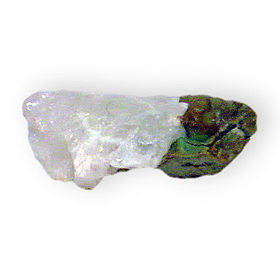- Allophane
-
Allophane[1]
Catégorie IX : silicates[2]
Allophane - Madalena, Nouveau Mexique, États-Unis Général Classe de Strunz 9.ED.20Formule brute Al2O3•(SiO2)1.3-2•(H2O)2.5-3 Identification Couleur incolore; blanc; vert; bleu; bleuâtre; jaune; brun; verdâtre; brun jaune Classe cristalline et groupe d'espace Amorphe Système cristallin Amorphe Réseau de Bravais Amorphe Cassure conchoïdale; terreuse; écailleuse Habitus Massif; croute; stalactitique; agrégat; pulvérulent Échelle de Mohs 3,00 Trait blanc Éclat vitreux; résineux; cireux; gras Propriétés optiques Fluorescence ultraviolet Oui et luminescence Transparence Transparent - Translucide Propriétés chimiques Densité 2,75 Propriétés physiques Magnétisme aucun Radioactivité aucune Unités du SI & CNTP, sauf indication contraire. Un allophane, est une espèce minérale du groupe des silicates sous groupe des phyllosilicates, composée de silicate d'aluminium hydraté, mal cristallisé, de formule idéale Al2O3•(SiO2)1.3-2•(H2O)2.5-3 avec des traces de Ti;Fe;Mg;Ca;Na;K. Sa composition chimique mal définie lui vaut une grande quantité de synonymes et de variétés.
Sommaire
Inventeur et étymologie
Décrite par les minéralogistes Johann Friedrich Ludwig Hausmann et F. Stromeyer en 1816[3], du grec antique "Allos" = autre et "Phainein" = paraître [4].
Topotype
- Gräfenthal, Saalfeld, Thuringe, Allemagne.
- les échantillons types sont déposés à l'École des mines de Freiberg Allemagne n° 26104.
Structure chimique
L’allophane sert de chef de file à un groupe de minéraux isostructuraux.
Groupe de l’allophane
- Allophane Al2O3•(SiO2)1.3-2•((H2O))2.5-3
- Hisingerite Fe2Si2O5(OH)4•2(H2O)
- Imogolite Al2SiO3(OH)4
- Neotocite (Mn,Fe)SiO3•(H2O)
- Zinalsite Zn2AlSi2O5(OH)4•2(H2O)
Gîtologie
- Dans les marnes (cas du topotype)
- Comme produits d'altération hydrothermal des cendres volcaniques et des roches ignées
Minéraux associés
Chrysocolle, cristobalite, gibbsite, imogolite, limonite, quartz, vermiculite[5].
Synonymie
- Allophanite[6]
- Carolathine (Sonnenschein) Est passée longtemps pour une allophane pauvre en eau[7].
- Collyrite : décrite à la mine d'Etienne à Schemnitz en Hongrie, à Weissefel en Saxe, Allemagne, mais aussi en France dans la vallée de Larboust dans les Pyrénées[8].
- Dillnite (Haidinger) : le nom vient de la localité de Dilln près Schemnitz en Hongrie[9].
- Elhuyarite (Glocker) : Petite masses botroïdales trouvées dans des filons de lignite à Freisdrof près de Bonn (Allemagne) [10]
- Ilbaite[11]
- Protoallophane
- Riemanite[12]
- Samoïte : le minéral initialement décrit dans une cavité de laves de l'ile Upolu Samoa qui a inspiré le nom[13].
- Scarbroïte (Wernon) : le nom vient des iles Scarborough où le minéral avait été trouvé[14].
- Schröttérite (Glocker1839) : Nodule au Dollinger Berg près de Freiestein en Styrie, Autriche[15].
Variétés
- Cupro-allophane : variété d'allophane riche en cuivre trouvée dans de nombreuses occurrences : Allemagne, Autriche, Suisse et Zaïre.
- Ferriallophane : variété d'allophane riche en fer décrite à Podol'sk, Moscovskaya Oblast en Russie.
- Phosphate-allophane : variété d'allophane riche en phosphore contenant près de 7.97% de P2O5 décrite à Whittier, Comté de Swain, Caroline du Nord, États-Unis[16].
- Plumboallophane : variété d'allophane riche en PbO.
Notes et références
- American Mineralogist, volume 061, pp. 379(1976)
- La classification des minéraux choisie est celle de Strunz.
- Hausmann, J.F.L. & Stromeyer, F. (1816): Über Silberkupferglanz und Allophan.- Göttingische Gelehrte Anzeigen 2, 1251-1253.
- MINER Database von Jacques Lapaire - Minéraux et étymologie
- The Handbook of Mineralogy Volume II, 1995 Mineralogical Society of America by Kenneth W. Bladh, Richard A. Bideaux, Elizabeth Anthony-Morton and Barbara G. Nichols
- Dictionnaire des sciences de la terre: anglais-français, français-anglais Par Magdeleine Moureau,Gerald Brace p.15 2000
- A handbook to the collection of kaolin, china-clay and china-stone. Museum of Practical Geology (Great Britain),John Allen Howe,Allan B. Dick p.162 1914
- Élements de minéralogie appliquée aux sciences chimiques : Volume 1 Par J. Girardin, H. Lecoq, Jöns Jacob Berzelius p.11 1837
- Annual report of the progress of chemistry, and the allied sciences, physics. Par Justus Liebig (Freiherr von) p.537 1852
- Bulletin / Société géologique de France, Volume 4 p.97 1835
- Glossary of mineral species - Page 95 1995
- Nouveau manuel complet de minéralogie, Volume 2 Par Jean-Jacques-Nicolas Huot p.502 1841
- Manuel de minéralogie, Volume 1 Par A. Des Cloizeaux P.199 1862
- Manuel de minéralogie, Volume 3 Par A. Des Cloizeaux P.590 1856
- Geological Survey professional paper, Numéro 185 Par Geological Survey (U.S.),Geological Survey (U.S.). Geographic Names Information Management p.145 1934
- Howard W.Jaffe and Alexander M.Sherwood, Phosphate-Allophane in an Epidosite from North Carolina
- Portail des minéraux et roches
- Portail de la chimie
Catégories :- Aluminium (minéral)
- Phyllosilicate
- Hydrate
Wikimedia Foundation. 2010.

